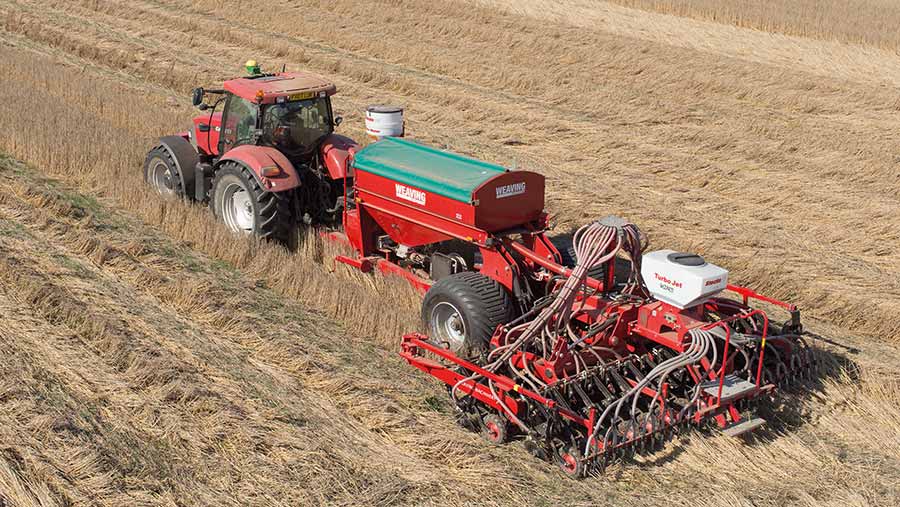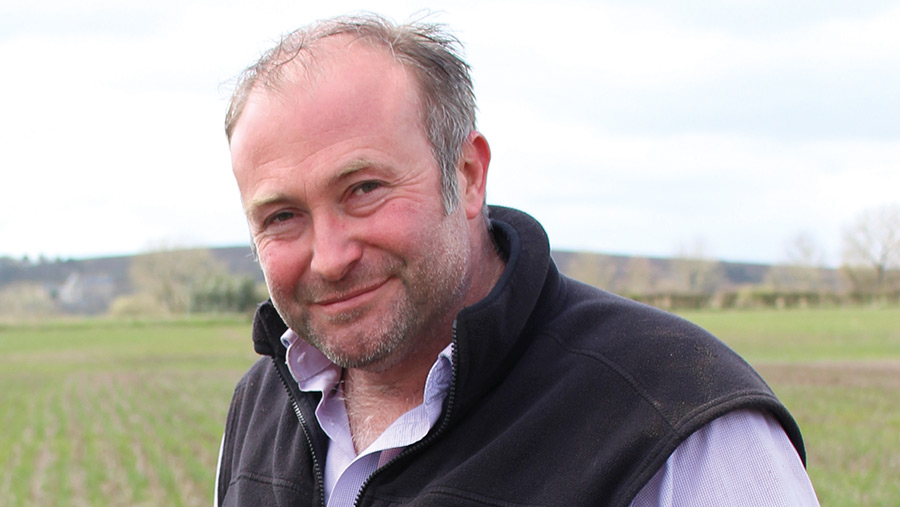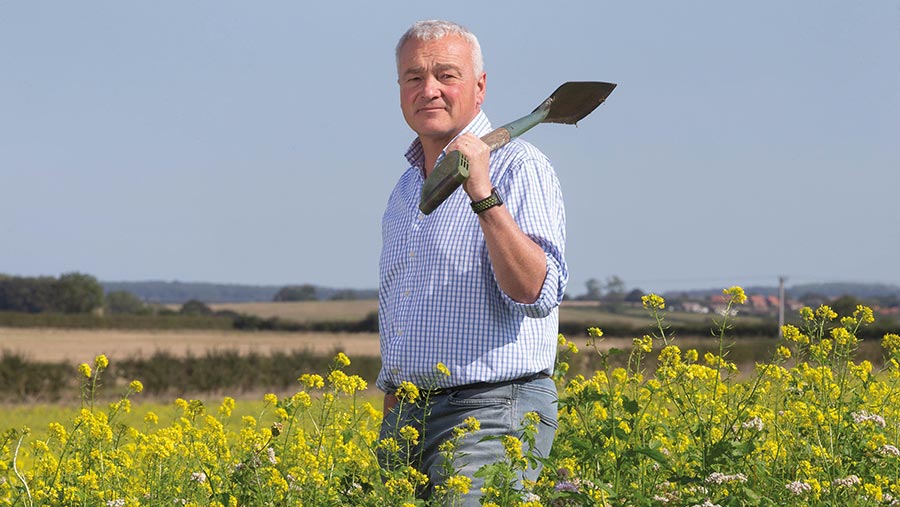UK
Regenerative farming: The theory and the farmers doing it
 © Tim Scrivener
© Tim ScrivenerRegenerative agriculture provokes strong opinions and passionate debate. There are those who are sceptical of the claims being made in its name, while others have completely bought into the idea that it is farming’s future, and the way to solve climate change.
Soil health is at its heart. The aim is to improve or restore soils that have been degraded by rebuilding soil organic matter and increasing soil biology.
Soils that are structurally sound and rich with organic matter and micro-organisms are better able to retain water and store carbon.
See also: How one Northants farmer is using cost maps to cut crop risk
The theory
The theory is that healthier soils lead to healthier plants and, hopefully, healthier profits, while helping to remove carbon from the atmosphere.
Typically, most regenerative farmers follow these four core principles:
1. Minimising soil disturbance
There are more micro-organisms in a teaspoon of soil than there are people of Earth, according to the US Department of Agriculture’s Natural Resources Conservation Service.
These living organisms create soil fertility, but disturbing them through tillage or by using chemicals destroys the soil structure that acts as their home.
2. Keeping the soil covered
Nature always works to fill a vacuum, and bare soil is no different. Keeping it covered protects it from wind and water erosion, while preventing moisture evaporation and weed seeds germinating.
Most growers choose to keep soil covered by maintaining living roots in the soil as much as possible through the year – typically by growing cover crops in the gaps between cash crops.
That also helps retain nutrients and food supply for the micro-organisms in the soil.
3. Maximising plant or crop diversity
The theory is that pests, diseases and poor nutrient cycling in crops are due to the lack of diversity in our farming system.
Increasing the range of crops and animals in the system decreases pest and disease pressure while supporting biodiversity and improving soil health.
4. Integrating livestock
Livestock grazing of cover or cash crops on arable land not only provides a natural source of organic matter, but also encourages new plant growth, which stimulates the plants to pump more carbon into the soil. This drives nutrient recycling by feeding biology.
Three-part series
The interest in regenerative farming has never been higher. So, in this new series, Farmers Weekly will be following three growers from different parts of the country at different stages of their regenerative farming journey to highlight how they are implementing the principles on their farms.
Over the course of the series, we want to delve deeper into regenerative practices, from minimising soil disturbance and cover cropping to integrating livestock into the arable rotation and reducing inputs.
We will provide tips and advice for those who want to switch to this type of farming, and further inspire those who already have.
Meet three farmers doing it
Edwin Taylor
Durhamfield Farm, Consett, Northumberland
Edwin Taylor © Richard Allison
Northumberland grower and Base-UK chairman Edwin Taylor grows just over 800ha of combinable crops alongside 300ha of grassland and 170 native breed suckler cows plus followers.

He is an early adopter of the principles behind regenerative agriculture,
There’s also an area of native woodland in a designated site of special scientific interest (SSSI)
Farming in partnership with his father, their “journey” – as he describes it – started back in 2002, with the aim to improve soil health and the condition of thefarm for the next generation.
Farm facts: Durhamfield Farm, Consett, Northumberland
- 1,100ha mixed farm
- 800ha arable growing wheat, barley, OSR, pulses and linseed
- 170 suckler cows plus followers
- Practicing regenerative agriculture principles since 2002
The three major management changes to their system include:
- growing 20-40% spring crops, rather than 100% winter crops as had happened previously
- the introduction of one- to two-year rotational pastures with legume mixes to make use of the livestock within the arable rotation and help tidy up grassweeds
- and minimal soil disturbance.
Cover crops are part of the mix, but Mr Taylor admits these are challenging. “Being in the north of England, our harvest is much later, which leaves less time to establish them successfully.
The ones we’re putting in are legume-based, nearly a living mulch, with the aim to keep some of the white clover for the following spring crop and depress the weed burden.”
He also is trying to direct drill winter wheat into a permanent clover living mulch to help reduce fertiliser requirements, some of which is made on the farm.
“I don’t think there’s a right or wrong way to farm – it’s what your personal preference is. But for me, I think this is the right way to achieve what we’re trying to achieve.
“It’s been a steep learning curve – every day is a school day,” he says. “We’re continuing to evolve and try new things, reduce cost, maintain output, try to be a little more environmentally friendly than our neighbours are, while at the same time trying to appease the bank manager.”
Nick Padwick
Ken Hill Estate, Snettisham, Norfolk
Ken Hill Estates on the west Norfolk coast was a blank canvas – albeit with owners who had a clear direction they wanted the farm to move in – when farm manager Nick Padwick took over two years ago.

“The key driver for the owners is the environment. That’s going to be really high on the government’s future agenda.”
The estate was just coming out of a Higher Level Stewardship agreement when Mr Padwick, a former Farmers Weekly Farmer of the Year, arrived, and he was tasked with planning the estate’s future direction.
Farm facts – Ken Hill Estate, Snettisham, Norfolk
- 1,400ha estate
- 600ha arable cropping
- 400ha rewilding area and 400ha traditional conservation
- Practicing regenerative agriculture since 2019
The result has been splitting the 1,400ha estate into three distinct areas:
- a water-penning structure has been introduced on the freshwater marshland to increase the water level for waders and wildfowl
- 400ha of marginal arable land and woodland bordering the marsh has been converted into a nature restoration area
- the remaining 600ha of arable land is being farmed regeneratively.
Cover crops have been introduced on 90% of the arable area, and a traditional winter crop-heavy rotation ditched for a much more spring-based regime.
Input use is being reduced dramatically, adds Mr Padwick. “The owners believe in using inputs in a responsible way, but want us to start focusing on whether there is the need to apply and whether there is an alternative.”
Max Chenery
Whatton Estate Farm, Long Whatton, Leicestershire

The move towards a regenerative system for Max Chenery’s 675ha farm increased in 2018 with the purchase of a Horsch CO8 drill with narrow openers, ironically from Edwin Taylor.
“It started as a commercial decision – the environment is very important – but we wanted to do some things differently to make some more money.
The old method isn’t working particularly well financially, and it’s going to get worse when we lose the subsidies.
“If I can knock £100/ha off cultivation costs and keep the same yields, that’s pretty important.”
The switch has been gradual, however, as Mr Chenery gains more experience and confidence with different practices.
Farm facts – Whatton Estate Farm, Long Whatton, Leicestershire
- 675ha mixed farm
- 370 Belted Galloway and Limousin cattle
- Practicing regenerative agriculture since 2018
“We’re concentrating on soil health, and doing whatever we can to improve it. We’re working towards no-till – some fields are no-till, on others we will light disc to level or subsoil on the heavy clay soils where we need to.”
Another important driver for the farm is the desire to reduce artificial inputs by increasing crop diversity and using companion cropping.
“If possible, I’d like to reduce nitrogen by 40kg/ha in wheat, cut herbicides by 15% and trim fungicides to only two applications across the farm.”
He’s happy to experiment to see what works best in his conditions.
With cattle on the farm, he’s comparing lucerne and red clover for silage, while another small area has been drilled with white clover to create a living mulch to direct drill wheat into, with the hope it survives through a four-year rotation.
No comments:
Post a Comment